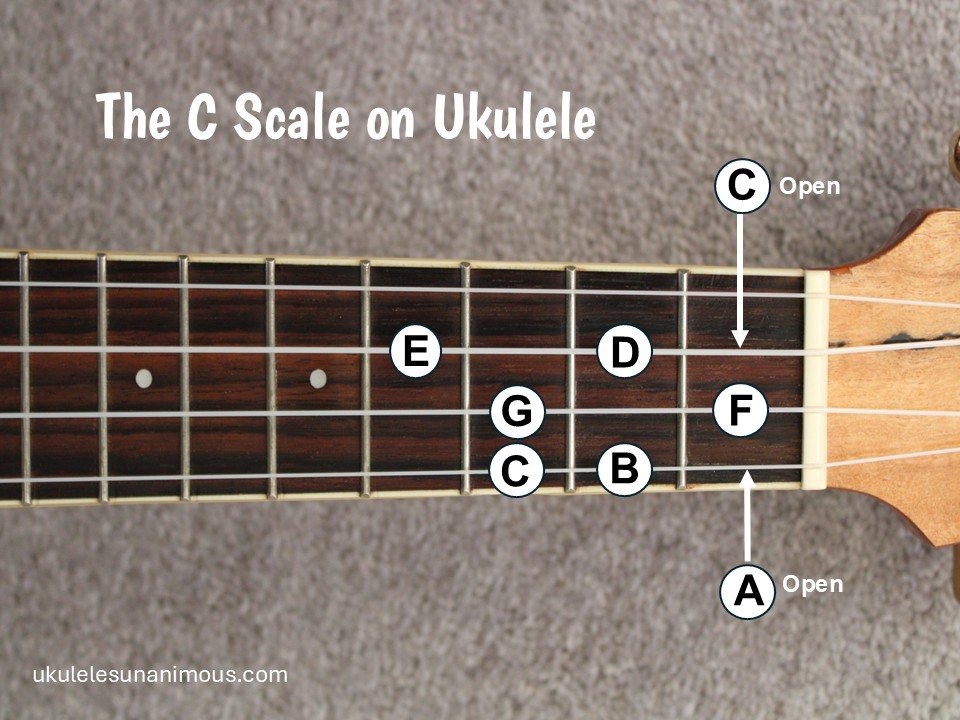The C Scale On Ukulele And Why It's Your New Best Friend!
Calling all ukulele beginners out there who are looking for a new challenge. Want to learn more than just playing chords? Today, we’re introducing you to one of the most essential building blocks of music: The C major scale. Whether you're a strummer or a picker, understanding and playing the C scale will open the door to new musical adventures on your uke.
Let’s break it down in true Ukuleles Unanimous style - learn, have fun, and get ready for action!
What is the C Major Scale?
The C major scale is like the alphabet of music, a series of notes arranged in a specific order:
C, D, E, F, G, A, B, C.
Think of these as the ‘do-re-mi-fa-so-la-ti-do’ that Julie Andrews sang about. On your ukulele, playing this scale is a mix of single notes that work beautifully for melodies, warm-ups, and building finger dexterity. Best of all? The C major scale has no sharps or flats, making it the perfect starting point for players of all levels.
How The C Major Scale looks on your uke
How to Play the C Scale on Your Ukulele
Here’s a step-by-step guide to playing the C scale in the first position (the lower frets of your uke).
Start by tuning your ukulele to standard GCEA. Ready? Let’s go string by string:
1. C string (3rd string):
Open (C)
2nd fret (D)
4th fret (E) or Open E (2nd string) if you prefer.
2. E string (2nd string):
1st fret (F)
3rd fret (G)
3. A string (1st string):
Open (A)
2nd fret (B)
3rd fret (C)
Congratulations! You just played the C major scale. Here’s how it looks in tab form for easy reference:
A |--0--2--3----
E |--0--1--3----
C |--0--2--4----
G |--------------
Why Learn the C Scale?
Knowing the C major scale is about more than just memorizing notes - it’s a gateway to understanding music on a deeper level. Here’s what you can do with it:
1. Build Muscle Memory
Playing the scale repeatedly helps strengthen your fingers and improve accuracy. It’s like yoga for your fretting hand!
2. Create Melodies
Want to start improvising or composing your own songs? The C scale is a goldmine for crafting simple, catchy melodies. Use it to experiment with tunes that sound naturally harmonious.
3. Explore Chord Progressions
The C scale is a foundation for understanding common chord progressions. Try pairing scale notes with chords like C, G, Am, and F - your ukulele will sing!
4. Warm-Up Like a Pro
Even the most advanced players use scales to limber up. Spend a few minutes with the C scale before you dive into your favorite tunes, and you’ll notice improved agility.
We learnt to play The C Scale!
Taking It Further
Once you’ve mastered the C major scale in the first position, challenge yourself to play it up the neck or combine it with other scales, like G or F major. And don’t stop there - try plucking the scale with different fingerpicking patterns or incorporating it into riffs and fills for songs.
Get Playing
The C major scale is more than just a technical exercise - it’s a tool for creative exploration and growth. Whether you're practicing it for warm-ups or using it to write the next chart-topping uke hit, the scale of C is your trusty companion. So grab your uke, pluck those strings, and let the music flow.
Want to up your game and take your playing to the next level?
Top Tip:
It’s great to play stuff you already know, but also focus on what you don't know and can't do in your practice sessions, and you'll develop faster.
Got a question or want to share your C scale jam? Drop a comment below - let’s talk music!
Happy Strumming 😊
Find more expert tips and practice techniques with our useful guides.



